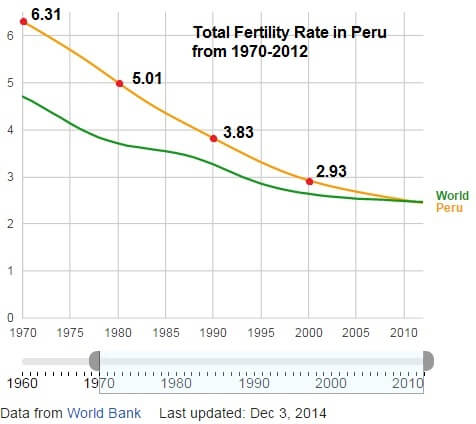In the mid 1990s, the president of Peru, Alberto Fujimori, created the “Voluntary Surgical Contraception Campaign” in attempts to control birth rates in Peru. This was created initially as a way to suit the economic needs of the country, as there were many poor indigenous people whom the government could not support. Although this campaign was advertised as voluntary, hundreds of thousands of women were forced to be sterilized. Many women were sterilized without their consent, and local clinic workers strongly encouraged women to stop having children once they already had five. Food was withheld from families who did not comply, and the lack of regulation and safety protocol caused physical and mental trauma in Peruvian women.
As Peru is considered a developing country, it had very high fertility rates compared to the world average in 1970. As shown in the graph, results from the forced sterilization brought Peru’s fertility rate down to the world average in 2102.

While the efforts technically succeeded in their goal of decreasing Peru’s fertility rate, they were very damaging to Peru’s society. Many of the procedures done were illegal, unsafe, and unethical. The president was arrested and tried for many crimes including the violation of human rights.
References:
Clowes, Brian (2017, January 26). “Exposing the Global Population Control Agenda.” Retrieved 5 February 2021 from https://www.hli.org/resources/exposing-the-global-population-control/?gclid=CjwKCAiA9vOABhBfEiwATCi7GHZErA6byHKqJ2OJSKwY9OABskfUHzd9FSCZjErHzlFHX08emMWFdBoCBMoQAvD_BwE
Lizarzaburu, Javier (2015 December 02). “Forced sterilisation haunts Peruvian women decades on.” Retrieved 5 February 2021 from https://www.bbc.com/news/world-latin-america-34855804
Suresh, Arvind (2014 December 11). “Forced sterilization in Peru: Did modern eugenic practices slow population growth?” Retrieved 5 February 2021 from https://geneticliteracyproject.org/2014/12/11/forced-sterilization-in-peru-did-modern-eugenic-practices-slow-population-growth/




 Find, present, and explain/describe an example of a population growth strategy that has been employed by a country to convince its population to have fewer children. Comment on the difficulty of such endeavors. Use graphical content to round out your posting.
Find, present, and explain/describe an example of a population growth strategy that has been employed by a country to convince its population to have fewer children. Comment on the difficulty of such endeavors. Use graphical content to round out your posting.